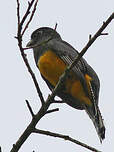Gartered Trogon
Trogon caligatus - Trogon à lunettes jaunes Trogon pattu
Identification
Birdwatching is a fascinating yet ever-changing science! The Gartered Trogon gets its French name from its yellow ocular circles, while Anglo-Saxon and Latin scientific names are generally related in all languages - who knows which idea they had when naming it! The Latin translation for Gartered Trogon could be caligatus - meaning soldier, black or dark. To make the Latin translation even more mysterious, part of the ornithologists consider the Trogon caligatus as a subspecies of the Trogon violaceus, whose differences rely in the proportion of black and violet blue on their heads. The Trogon caligatus measures 23 to 25 cm, while the male's beak is pale blue and its eyes are surrounded by yellow orbital circles. Its back of the neck, nape and throat are usually blue-violet and often appear black in the light (similar to the Trogon violaceus' subspecies braccatus, sallaei and concinnus, which can be seen in the Panama border and its head is fully black). The chest is violet blue, separated from the yellow belly by an apparent white line; the mantle and back are green with a few faint blue reflections in the back and the scapularies are green. Other characteristic of the Trogon is the fine white and black vermiculations in the coverts, which look a bit darker in the primaries - except for the remiges, which are black and not very marked compared to other Trogons'. The three lower pairs of rectrices are horizontally striped in black and white and present a more noticeable white mark at the tip; the white patch at the tip of the tail is bigger. The higher rectrices are emerald green and have a sharp black marking at their ends.Is the Gartered Trogon more enticing with her gaiters? Grey head with anthracite forecrown, the eye is outlined by two half white circles in front and behind the dark brown eye, the pale blue beak is marked with dark grey on the upper mandible. The grey chest is separated from the bright yellow belly by a more visible white line than in the male; the mantle and back are grey, the coverts are black striped horizontally with very neat white lines, the black remiges are marked with white at the tips, the tail is marked in the same way as its companion. The tarsi, little visible, are grey, the female hiding her gaiters! Juveniles take on the plumage of their mother, young males starting to have some green reflections on their back.
Subspecific information 3 subspecies
- Trogon caligatus caligatus (n Colombia, w Venezuela)
- Trogon caligatus sallaei (s Mexico to Costa Rica)
- Trogon caligatus concinnus (Panama through w Colombia to w Ecuador and nw Peru)
Foreign names
- Trogon à lunettes jaunes,
- Trogón violáceo,
- surucuá-calçado,
- Grünschwanztrogon,
- Goulds Trogon,
- Trogone violaceo settentrionale,
- gouldtrogon,
- Monokkeltrogon,
- trogón stužkatý,
- Violethovedet Trogon,
- väliamerikanpikkutrogoni,
- trogon wyżynny,
- Желтобрюхий трогон,
- ガーターキヌバネドリ,
- 斑尾美洲咬鹃,
- gouldtrogon,
- 帶紋美洲咬鵑,
Voice song and call
Habitat
East of Panama (Darien province), up to 900 m on the foothills of the Central American Cordillera, the Gartered Trogon can be spotted in the tropical forest as well as preferable semi-open spaces or the edges of forests. The same goes for Colombia where it can be seen in secondary forests, semi-desert areas as well as by marshes.
Dietfeeding habits
The Gartered Trogon, one of the more frugivorous trogons, is known to sometimes follow Melanerpes aurifrons, the golden-fronted woodpecker that enjoys oranges, and feed on the fruits opened by the picid. The insects it will actively seek, particularly during the nesting season, are of all kinds: wasps, ants, termites, caterpillars, all kinds of arthropods.
Reproduction nesting
The breeding period is in March in Colombia, January in Panama and February in Venezuela. The couple digs their nest in old trees or arboreal termite mounds, in Panama, American ornithologist Alexander Skutch (1904-2004) observed in 1981 in the canal zone a Violaceous Trogon, probably a Gartered Trogon, digging its nest in the roots of an epiphyte, Polypodium crassifolium at a height of 9 m.
The couple excavates the nest together, the incubation period is little known, the parents usually feed two chicks who leave the nest after 17 days.Geographic range
If the Violaceous Trogon is distributed from Southern Mexico to Northeastern Brazil, the Gartered Trogon is located in the center and east of Panama, north of Colombia and west from Venezuela. Location remains essential for identification, confusions, due to the small difference between one subspecies and another, will be avoided by the observation site.
Threats - protection
Sources of information
- IOC World Bird List (v15.1), Gill, F and D Donsker (Eds). 2025-12-07.
- A Natural history of the Trogonidae, Joseph M.Forshaw Albert Earl Gilbert
- The Birds of Panama, George R.Anger Robert Dean
- Vol. 6 - Handbook of the Birds of the World, Josep del Hoyo-Andrew Elliott-Jordi Sargatal
- xeno-canto, Sharing bird sounds from around the world,
- Avibase, Lepage Denis
- BirdLife International, BirdLife International
- Neotropical Birds Online,
- Wikipédia, Wikipedia, The Free Encyclopedia
Other sources of interest
 Specification sheet created on
31/07/2023 by Anne et Gabriel Leboff
Specification sheet created on
31/07/2023 by Anne et Gabriel LeboffTranslation by AI Oiseaux.net
© 1996-2025 Oiseaux.net
- Accipitriformes
- Aegotheliformes
- Anseriformes
- Apodiformes
- Apterygiformes
- Bucerotiformes
- Caprimulgiformes
- Cariamiformes
- Casuariiformes
- Charadriiformes
- Ciconiiformes
- Coliiformes
- Columbiformes
- Coraciiformes
- Cuculiformes
- Eurypygiformes
- Falconiformes
- Galliformes
- Gaviiformes
- Gruiformes
- Leptosomiformes
- Mesitornithiformes
- Musophagiformes
- Nyctibiiformes
- Opisthocomiformes
- Otidiformes
- Passeriformes
- Pelecaniformes
- Phaethontiformes
- Phoenicopteriformes
- Piciformes
- Podargiformes
- Podicipediformes
- Procellariiformes
- Psittaciformes
- Pterocliformes
- Rheiformes
- Sphenisciformes
- Steatornithiformes
- Strigiformes
- Struthioniformes
- Suliformes
- Tinamiformes
- Trogoniformes

































